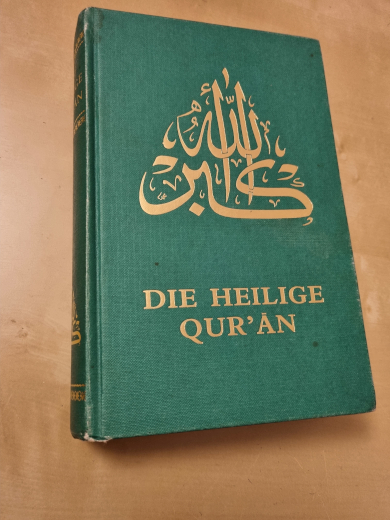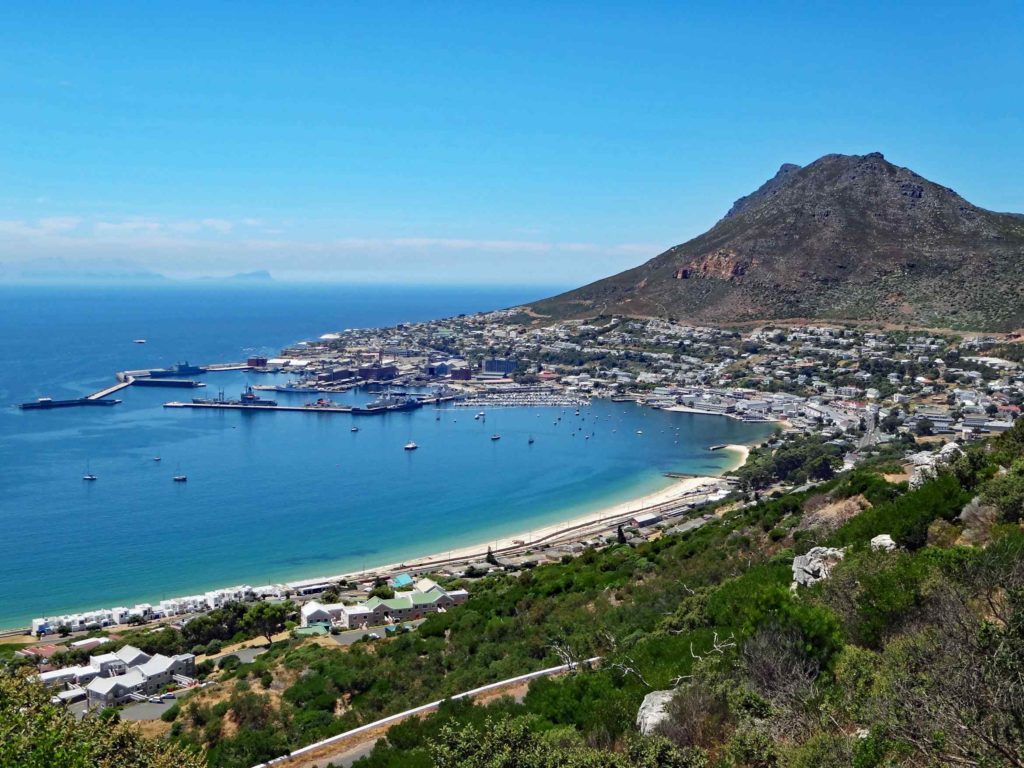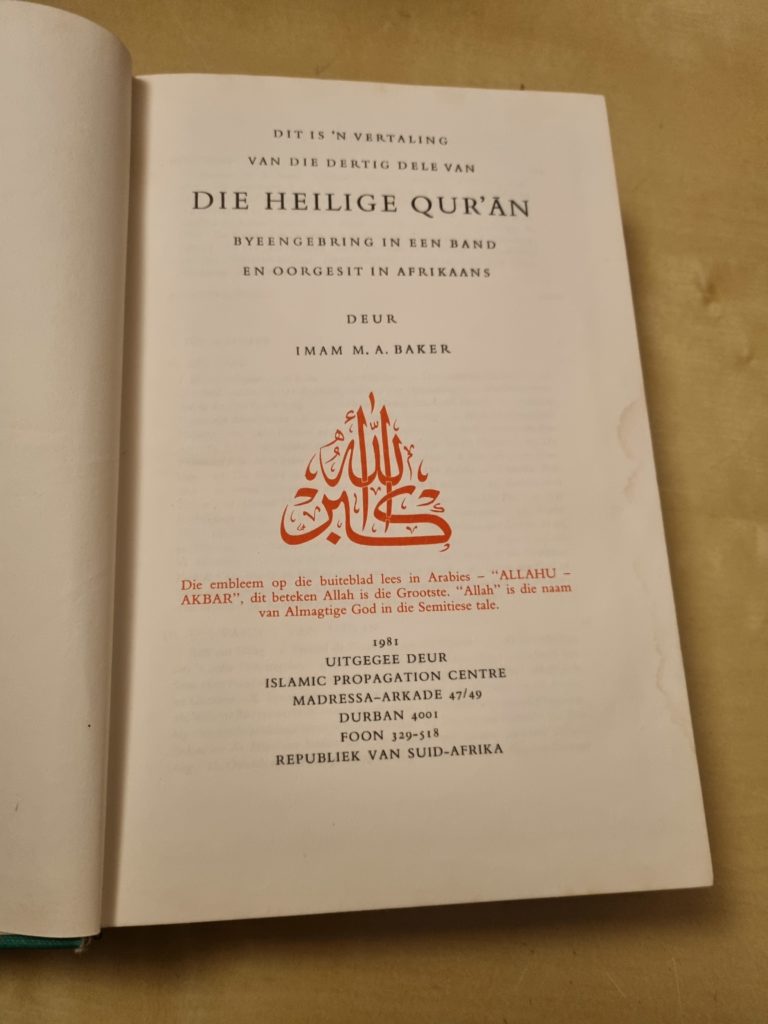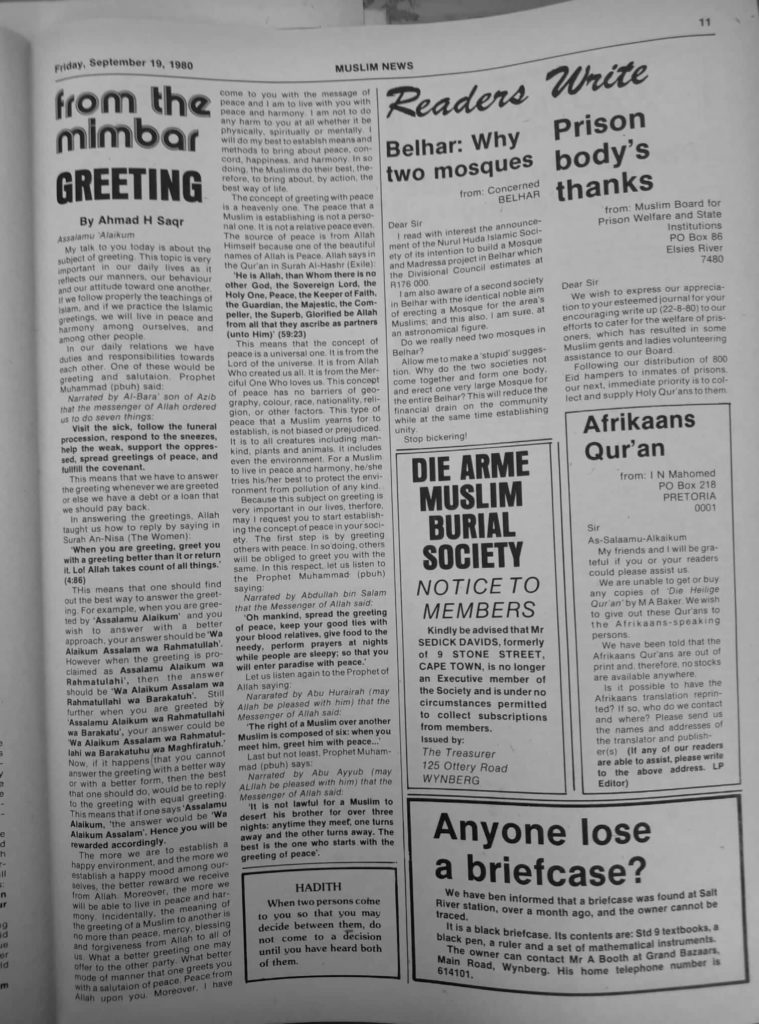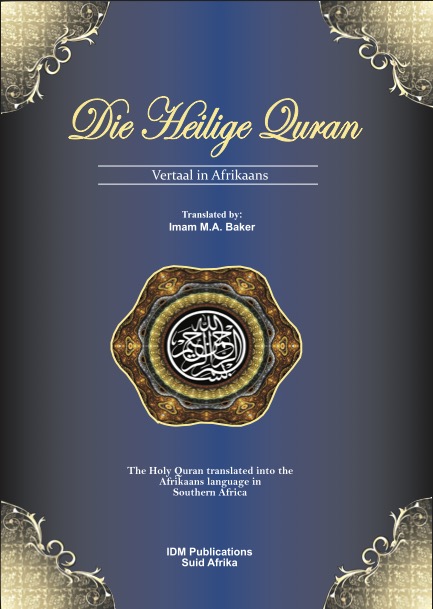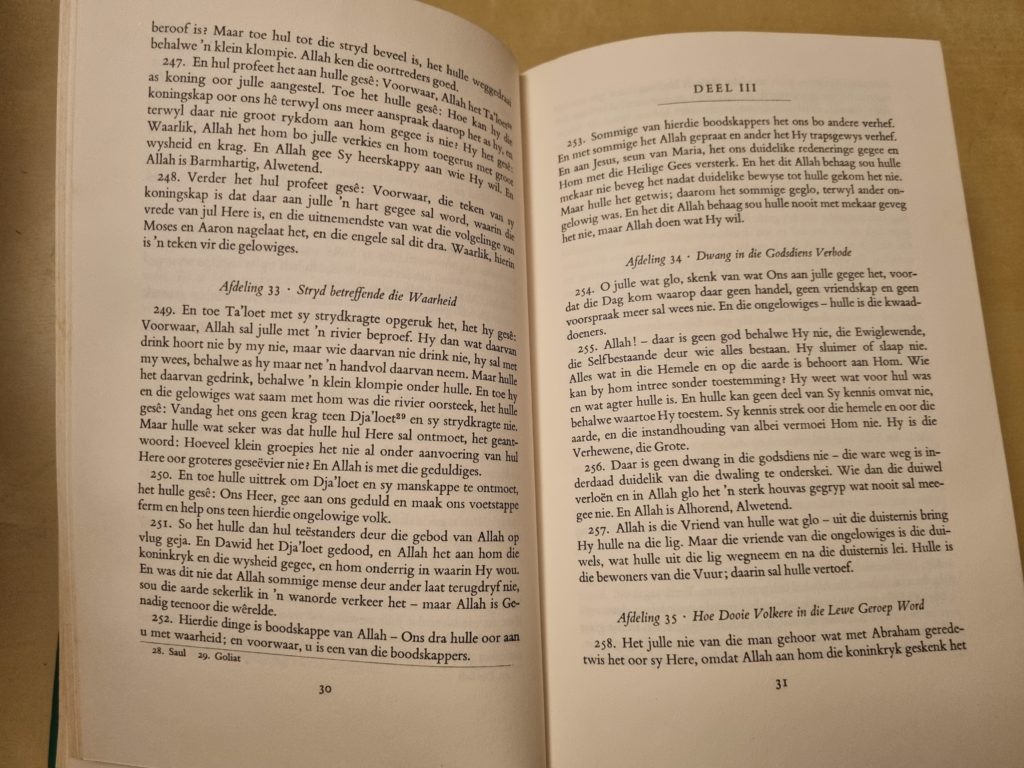The history of the first Afrikaans Qur’an translation throws a spotlight on the afterlives of slavery and colonialism, the international movement of texts and ideas in the twentieth century, and the disruption of modern South African history.
‘Die Heilige Qur’ān’ by Imam Mohammed Armien Baker (1910–1982) was first published in 1961 by Nasionale Boekhandel, in Cape Town. Baker was the imam of the Noorul Islam Mosque in Simon’s Town (Afrikaans: Simonstad), a naval settlement near Cape Town, and also principal of the Muslim primary school. Typical of the Western Cape region, it was home to a large number of people who were classified as ‘coloured.’ In the South African context, this was a legal category that comprised anyone who was not classified as white, black or ‘Indian,’ such as mixed-race persons and non-Indian Asians. In Western Cape, most of the ‘coloured’ population consisted of Muslim Malays. In 1960, Simon’s Town had 8,676 residents, of which 3,579 were coloured and 3,482 white.
The presence of Muslim residents in the town goes back to at least the eighteenth century when the Dutch brought slaves from the Malay archipelago to work for them. As early as 1823, a Malay burial ground was granted to the local Muslim community who had petitioned for it under the leadership of their imam, himself an enslaved man. In 1834, the British abolished slavery and the slaves were emancipated, most of them continuing to earn their living through menial jobs.
https://commons.wikimedia.org/wiki/File:Simons_Town_South_Afrika_S%C3%BCdafrika_(34436719644).jpg
For a long time, the Muslim community worshipped in private homes, but in 1888 they rented a building to use for communal worship and as a venue for important community meetings. In 1911, they had raised sufficient funds to buy it and some adjacent land, and commenced fundraising and building. In 1923, a Muslim school was opened in which more than 100 students enrolled, and the new buildings of the Noorul Islam Mosque were completed a few years later in 1930. All this was accomplished through donations, even though few members of the local Muslim community were affluent and many were poor. Between the 1920s and the 1960s, Muslim life flourished in Simon’s Town; in addition to the vibrant local community, the port and dockyard brought in Muslim sailors from Java and other parts of Asia who frequented the mosque. It was during this period that Mohammed Armien Baker was active and ultimately produced his Qur’an translation.
Baker was a fifth-generation resident of Simon’s Town, the eldest of twelve children of a fisherman. After he received his teacher’s diploma, he became principal of the Muslim school in 1930, at the young age of twenty. He started working on his Afrikaans Qur’an translation in 1956 and completed it in 1960. When it was published in 1961, he dedicated it to his first wife, Tayba, who had just passed away.
Baker’s choice of Afrikaans, a variant of Dutch brought to South Africa by the Dutch settlers and slaveholders, for his Qur’an translation might seem counterintuitive. But, in fact, Afrikaans had been the lingua franca of the Malay community for a long time. In the nineteenth century, it was considered the language of coloured and working-class people. Upper-class, educated Afrikaners – the descendants of Dutch settlers – insisted on speaking proper Dutch, shunning Afrikaans as an uncultured creole riddled with Malay loanwords. (The most noticeable of these is ‘baie,’ from the Malay ‘banyak,’ meaning ‘many,’ ‘much’ or ‘very.’)
In the first half of the twentieth century, Afrikaans was increasingly promoted as a literary language by white Afrikaners who were trying to create a distinct ethno-national identity: the first translation of the Bible into Afrikaans was published in 1933. Malay Muslims were, of course, not seen as part of this race-based and exclusionary project of identity building. Still, most of them continued speaking Afrikaans as their first language, and today Afrikaans has more coloured speakers than white ones.
Baker’s Qur’an translation was published by the biggest Afrikaans publisher in the country, Nasionale Boekhandel (NB). Ironically, NB was, and still is, owned by Nationale Pers, a media company that was the mouthpiece of the National Party, the main architect of the apartheid regime. Imam Baker and the vibrant Muslim community of Simon’s Town fell prey to that regime when, in 1967, the Group Areas Act was implemented in their town. The Act consisted of a series of laws that, from 1950 onwards, restricted residential and business areas to specific racial groups, thereby excluding people of colour from many urban spaces and practically all the most desirable residential areas. The Cape Times reported on Imam Baker’s passionate and futile plea in front of the Group Areas Board to prevent this from happening:
‘My father, and his father and his father’s father were born and bred in Simon’s Town. You see, we have been there for 200 years. I will lose my birthright – my ancestors were the first people to settle in the area. If I move to Bonteheuwel I will become nothing, merely a number. They have no hospitals, no police station, no church, no school. A man can be subjected to such disintegration that he will lose his spirit.’
Although only 40% of Simon’s Town’s inhabitants were white, the area was defined as white in 1967 and the majority of inhabitants were forced to relocate. Baker, who had retired from his post a short while ago and just returned from the pilgrimage to Mecca with his second wife, moved to Wynberg, a suburb of Cape Town with a sizeable coloured population. There he served as a welfare clerk and the local imam.
Baker’s Qur’an translation remains the only full translation of the Qur’an into Afrikaans to have been published, and has repeatedly been reprinted, for example by the Islamic Propagation Centre in Durban in 1981 (interestingly, the writer of a letter to the editors in the ‘Muslim News’ had complained in 1980 that it was impossible to obtain the translation). In 2001 the Islamic Dawa Movement (IDM) of Southern Africa in Durban published a new edition that had been proofread, ‘rectified’ and approved by the Muslim Judicial Council of South Africa. This edition is also available online.
That the IDM saw a need for rectification had one major reason: Baker had quite obviously heavily relied on the English Qur’an translation by Muhammad Ali (1917) or, more likely, on the 1934 translation of this into Dutch by Soedewo, an Indonesian Muslim (https://gloqur.de/quran-translation-of-the-week-21-soedewo-and-the-dutch-quran-in-indonesia/). Muhammad Ali was an adherent of the Lahore Ahmadiyya, which follows the teachings of Mirza Ghulam Ahmad (d. 1908) from India and has been emphatically rejected by non-Ahmadiyya Muslim scholars and institutions. However, Baker does not admit to his indebtedness to Muhammad Ali; he claims that his translation was made from the original Arabic and subsequently corrected against ‘various’ Dutch and English translations. But while he does not slavishly follow Ali or Soedewo, the similarities between his translation and theirs are striking and much greater than the similarities with other Qur’an translations that he might have had access to, such as Yusuf Ali’s and Pickthall’s. It is small wonder that a partial Qur’an translation published in 1989 by the Qadyan Ahmadiyya followed Baker’s text quite closely.
Baker’s introduction largely consists of excerpts from the introduction to Muhammad Ali’s/Soedewo’s Qur’an translation, arranged to be more accessible to a non-Muslim audience. For example, Baker replaced the lengthy section on the details of ritual prayer with a short paragraph describing prayer in general terms. He also used the same section headers as Muhammad Ali/Soedewo, who divided the longer suras into thematic sections.
In the text of the translation, the most conspicuous borrowing from Muhammad Ali that clearly points to Ahmadiyya ideas is Baker’s rendering of the ants (Ar. naml) that Solomon is able to speak to (Q 27:18) as ‘Naml,’ or ‘Namliet’ (‘Namlite’) in the singular. Muhammad Ali, in contrast to all earlier exegetes, interpreted the word naml to denote a tribe, rather than an insect. This is because he took great pains to avoid any evidence of prophetic miracles, and therefore consistently looked for translations that allowed for rational explanations, even if they went entirely against the mainstream of Muslim exegesis. In the same vein, Ali refused to accept that Jacob, in his old age, regained his eyesight after the shirt of his lost son Joseph was put on his face; rather, he translated this as Jacob having gained certainty (Q 12:96). Here, too, Baker followed him. A similar motive is behind the translation of the kursī, the ‘seat’ or ‘Throne’ of God in the famous ‘Throne verse’ (Q 2:255), as ‘knowledge’ or, in Baker’s terms, ‘kennis.’ In this version, the ‘Throne’ is not only understood as a metaphor; it is completely replaced with a different concept because the idea that God might have a seat seemed inconceivable to Muhammad Ali, even as a figure of speech. While the metaphorical interpretation of kursī as a signifier for wisdom, knowledge, power or dominion is common in mainstream Islamic theology, choosing to erase the literal meaning of the word entirely from the translation, and narrowing it down to just one of the various possible metaphorical meanings, is highly unusual.
However, while Baker adopted a number of quite idiosyncratic and far-reaching translations from Soedewo, he also made his own choices. Some of his translations, especially of the short suras at the end of the Qur’an, bear little resemblance to Soedewo’s, and his rendering of the sura names differs from Soedewo’s, too. Moreover, Baker made some changes and additions to the original Arabic text that are not present in Muhammad Ali’s or Soedewo’s translation and that clearly have an apologetic purpose. For example, in Q 4:34, a husband is given permission to ‘beat’ his wife, according to Muhammad Ali’s translation (or Soedewo’s, who has ‘sla’). In Baker’s translation, he is allowed to ‘discipline’ (‘tugtig’) her, which might or might not be interpreted as corporal punishment.
To give another example, in Q 5:51 the believers are instructed not to take the Jews and Christians as their awliyā’, which Muhammad Ali renders as ‘friends’ (Soedewo: ‘vrienden’). Baker follows them in this, but in his translation the whole sentence reads as follows:
‘O julle gelowiges, neem nie die vyandiggesinde Jode en Christene as vriende nie.’ (‘O you believers, do not take the Jews and Christians who are hostile towards you as friends.’)
The adjective ‘vyandiggesinde,’ which denotes those with a hostile disposition, is an addition that can be found neither in the Arabic wording of the verse nor in Muhammad Ali’s and Soedewo’s translations. Baker probably felt a need to make such changes and additions because his translation has barely any annotation. The few notes it does have are mostly limited to one- or two-word glosses. He also uses footnotes to provide interpretations of the disjointed letters at the beginning of many surahs. For example, Alif Lām Rāʾ is explained as ‘I am Allah, the Seeing.’ These interpretations are identical to Muhammad Ali’s translation but whereas Muhammad Ali replaces the disjointed letters with them, Baker relegates them to explanatory annotations. Another important difference to Muhammad Ali/Soedewo is Baker’s decision to use ‘Allah’ to denote God, while Muhammad Ali and Soedewo use ‘God.’
The 2001 edition left many of Baker’s decisions untouched, even where they might be controversial or not entirely literal, but the editors changed those that pointed all too obviously to Baker’s Ahmadiyya sources. For example, they replaced the ‘Namlites’ with ‘ants’ and they also changed Baker’s translation of Q 3:54, in which the issue of Jesus’ death and ascension is addressed, of which the Ahmadiyya have a different understanding than other Muslims. They believe that Jesus, after the failed attempt to kill him by crucifixion, continued to live on earth until he died of a natural death in Kashmir. Baker, like Soedewo, accordingly translated God’s words to Jesus, as ‘O Jesus, I will let you die and raise you into My presence’ (‘O Jesus, Ek sal u laat sterwe en u in My aanwesigheid verhef‘) whereas the 2001 editors changed it to ‘O Jesus, I will raise you up and elevate you into My presence’ (‘O Jesus, Ek sal u ophef en u in My teenwoordigheid verhef‘), pointing to the belief that Jesus’ ascension might have preceded his death. While non-Ahmadiyya Muslim positions on the death of Jesus are not unanimous, many translators take great care to avoid any association with Ahmadiyya beliefs – as is evident from the intervention of editors of the 2001 edition of Baker’s Qur’an translation.
Baker’s translation has earned him lasting fame. It bears witness to a period in which Muslims in South Africa were striving to leave the past of slavery behind, were achieving upward social mobility and self-confidently building active religious communities. Those efforts were all but destroyed by the apartheid regime that tore communities apart and was the cause of immeasurable loss. And yet, as ‘Die Heilige Qur’an’ shows, despite this they continue to bear fruit until today.
Johanna Pink
With special thanks to Margherita Picchi for her generous help with the research for this blog post!
